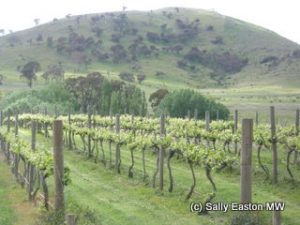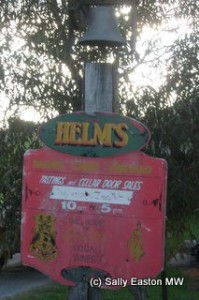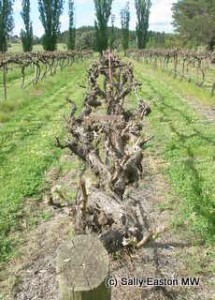Canberra District – riesling rising

Canberra vineyards
Canberra seems to get a bum rap from Aussies who don’t live there. OK, it is an artificially created capital city, but the whole point is that it isn’t Melbourne, and it isn’t Sydney. And in 2013 Australia’s capital city celebrates its centenary.
A rather newer point is a strongly emerging wine region.
The city itself is more than 550m above sea level, and Canberra District wines come from vineyards at altitudes ranging from 500m to 800m. The three dozen or so producers are less than 45 minutes from the city of Canberra, though mostly this means they and their vineyards lie just over the border into New South Wales.
Being a capital city, it’s where many of the national institutes are based and the CSIRO (Commonwealth Scientific and Industrial Research Organisation), Australia’s national science agency, is no exception. Indeed the early modern history of Canberra’s wine industry is due to wine-enthusiastic CSIRO scientists setting up vineyards from the 1960s, with the first commercial wineries dating from 1971 – Clonakilla and Lake George.
A few of these ex-CSIRO wineries are now well-established classics. Clonakilla’s Shiraz/Viognier was elevated to the top, ‘exceptional’, level in the latest Langton’s classification, announced earlier this year. Helm Wines’ rieslings are liberally showered with wine show medals and trophies. Ken Helm, who founded and runs the Canberra International Riesling Challenge, established his riesling-specialist winery in 1973. Other originals include Lark Hill, the highest vineyard in Canberra at 860m, and Brindabella Hills.

Helm Wines
Along with this handful of established properties, Canberra has taken off significantly in the last few years with a renewed sense of enthusiasm. Several new growers had come into viticulture a decade previously as Hardy’s (Constellation) signed up 10-year contracts for fruit. Most of those ended a couple of years early, leaving growers with nicely established vineyards, though needing somewhere to put the fruit. This is coming out under the growers’ names, several of whom said that the best, and the best, thing Constellation did was (a) coming into the region and (b) leaving the region. Certainly the company kick-started grape growing in a way that has given individual producers critical mass to now market their own wines.
It’s also meant a fresh, vibrant new generation of young winemakers has settled in the area and are ready to put to good use fruit that’s become available. Alex McKay of Collector Wines, and Nick O’Leary, and are both ex-Hardy’s, now making their own wines, O’Leary eponymously. He said “My first vintage [under his own name] was 2006. Alex [McKay] and I bought fruit from the growers who Constellation paid off.”
Add in Nick Spencer to the mix. He arrived in 2008 to make wine for Eden Road Wines, and he now doubles as the president of Canberra District Wine Industry Association. In summing up the general style of ‘high country’ wine, Spencer said “they’re not European but they are a style on an international stage. The wines are food friendly, elegant and medium bodied. They’re not big fruited, dark chocolate wines.”
With Canberra being cited as being the second sunniest city in Australia, after Perth, the climate is not exactly cool, though nor is it Barossa-hot. And though the days do get pretty hot during the ripening period, the altitude, with the Snowy Mountains not too far distant, means night time temperatures drop considerably, which means more of the natural acidity is retained in the fruit, adding brightness and verve to the wines. Another ex-Hardy’s grower Richard Parker of Long Rail Gully Wines, said “We’re not Tassie cool [but] we get a big diurnal.”
So while the summers get very hot, around 39°- 42°C, there are extenuating circumstances that bring a moderate style to the wines being made here. Springs are cool and wet, autumns are cool. And even though the ocean is about an hour and a half east, Helm said “Bateman’s breath [an easterly sea breeze] comes in nearly every day in the summer around 8pm, dropping night temperatures to around 15°C.” McKay added that as well as dropping temperatures, the breeze relieves vineyard stress by bringing humidity.

Canberra vines
Such a climate is too warm for pinot noir, but riesling, along with shiraz, are the favoured grape varieties, though the usual suspects are all there, plus a bit of sangiovese and tempranillo. (Shiraz will feature by itself, later.)
Spencer summed up the emerging style for Canberra riesling, saying “it’s lighter, less aromatic and intense than Clare. It’s more racy, minerally and tighter, with a bit more acid, and floral, lemon-limey flavours.
For O’Leary “2008 was the best riesling year for a long time, with a cool growing season, no sunburn, with beautiful acid and fruit.” With 7-8g/l residual sugar, O’Leary’s 2008 riesling is brightly balanced with lime and apple notes running through its smoothly textured core. O’Leary focuses on free run juice, taking some 450 to 500 litres from a tonne, when generally up to 750 litres of juice in total can be extracted, including pressings. He said his pressings go to another tank.
The 2010 vintage was trickier, with 180mm of rain a fortnight before harvest. Spencer’s Eden Road, The Long Road Riesling 2010, has just 4g/l residual sugar which lifts the floral, apple blossom perfume of this light bodied, but intensely flavoured young wine.
At Clonakilla, Tim Kirk’s assistant winemaker Bryan Martin said “we prefer less ripe aromas in the riesling. It’s the spice and florals that make Canberra District different.” Their 35th vintage of riesling, the 2010, an intense, aromatic, limey, layered, long and excellent medium bodied wine, had some frozen juice added back to the wine to lift the perfume, resulting in a wine with 4g/l residual sweetness. Which means dry.
But it is Helm Wines that leads the field for riesling. Two are made: ‘premium’ when grapes are perfect, from a single vineyard, and ‘classic dry’ which is a blend across vineyards. Helm said “I want to express vineyards. I crop around 3 tonnes to the acre (around 50 hl/ha), without stress from over-cropping or from not enough water. I use no lees.”
In addition, he said “I control fermentation to ferment 0.7 Baumé per day. Towards the end of fermentation, I turn off the cold and let it finish itself. The wine might end up with 3 or 5 g/l of residual sugar.” He warned that going above 12.5% alcohol results in over-ripe characters, which he regards as a fault.
He’s definitely been onto something for some time, because both styles show an extraordinary consistency, intensity, purity, tautness, steeliness and linearity, with the ‘classic dry’ a bit more open and accessible.
While the old world model for riesling is one of cool climate and marginal sites, the Aussie model, in Canberra and elsewhere, suggests the grape variety is climatically forgiving, and able to produce intense, tight wines in an Aussie paradigm that’s very different from that of the old world.
My research visit to Australia in October 2010 was sponsored by Wine Australia.



